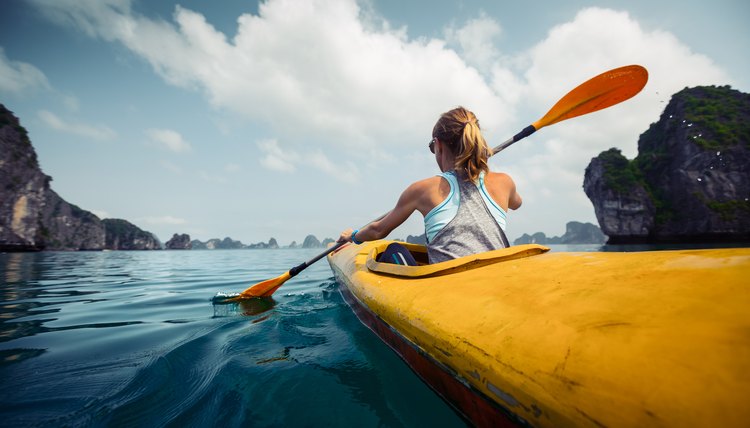What does fact checked mean?
At SportsRec, we strive to deliver objective content that is accurate and up-to-date. Our team periodically reviews articles in order to ensure content quality. The sources cited below consist of evidence from peer-reviewed journals, prominent medical organizations, academic associations, and government data.
The information contained on this site is for informational purposes only, and should not be used as a substitute for the advice of a professional health care provider. Please check with the appropriate physician regarding health questions and concerns. Although we strive to deliver accurate and up-to-date information, no guarantee to that effect is made.
What Muscles Does Kayaking Work?

What's not to love about kayaking? Out in nature, potentially experiencing marine life depending on where you are, it's beautiful. And as if that wasn't reason enough to get after it, your upper body is in for one heck of a workout.
Tips
Kayaking works muscles in your back and arms while torching calories.
Muscles Used in Kayaking
Your back, shoulders, arms, hands, abdomen, chest and especially heart are key muscles used in kayaking. Even an hour of kayaking will produce more work for these muscle groups than you'd probably hit in any single gym session.
The Back Attack
With proper kayaking technique, every stroke you take is a single-arm row. Picture doing a single-arm dumbbell row or seated cable row; it’s basically the same motion with a paddle. Every stroke works the lats to a great degree. While one arm is rowing back, the other is getting a stretch and then a contraction. It’s an effective back workout and you can go at whatever tempo or variation you like: sprints, long sets, each pull as hard a possible, wide grip or narrow grip.
Build Boulder Shoulders
Generally, any time that you do a back workout, you will be hitting the shoulders, especially the rear head of the deltoid. In the case of kayaking, the direct impact on the shoulders is much more involved than a typical back workout. At the end of each stroke, the paddle has to come up and around to the front again.
This motion transfers the load from the large lat muscle up to the shoulders. That forward circular motion really attacks the rear, lateral and anterior delts. Again, varying the tempo and the width of your grip will vary how the muscles are worked.
Guns and Grip
Like any other rowing workout, the biceps are among the muscles used in kayaking. During this activity, the triceps actively contract as well. As one arm is rowing in, hitting the biceps on that side, the other arm is countering with a forward extension to create more torque on the paddle. That extension involves a lot of triceps.
As the biceps and triceps are doing their thing, your grip and forearms are getting attacked by handling and maneuvering the paddle. Like high-rep pullup workouts, your hands will fatigue and your forearms will be tested during a kayaking session.
Abs of Steel
As with all rotational movements, the abdomen and obliques are heavily involved and responsible for your performance. If you have weak core muscles, good luck getting through a demanding kayaking session with any kind of pride. Your trunk, which runs from your waist to your neck, is constantly working in a rotation and counter-rotation manner, resulting in a huge demand for spine stabilization and balance.
Expecting to kayak without taxing your abdomen and core is like expecting to win an auto race with a faulty axle between your wheels.
Pecs for Real and More
Like the triceps involvement in kayaking, the chest is also involved. When one arm is rowing back, the other is countering with a forward push, like a single-arm dumbbell bench press. The interesting part is that when you do any row, your pectoral muscles actually work to stabilize the shoulder and pull the arm in, so the chest works on both arms simultaneously in opposite fashions.
And if it wasn't obvious, kayaking is a cardio-respiratory onslaught. Whether you sprint or coast, your heart and lungs will be tested on every single row for the duration of your adventure.
References
Writer Bio
Ryan Mess earned a Bachelor of Arts in communications from Cal Poly SLO, where he played rugby. His fitness expertise bloomed during his college and semi-pro rugby career. And since then, he has been training everyone from youth to professional athletes to grandparents in all things fitness and health while still competing.
